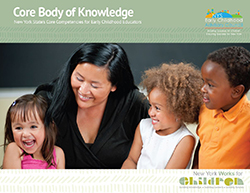Core Body of Knowledge
NY's Core Competencies for Early Childhood Educators
Navigation
Competency Description
The professional working with young children works to effectively and calmly address challenging behavior
Behaviors & Skills
a
Considers whether or not his or her expectations of behavior are appropriate for the age and development of the child
b
Responds to challenging behavior in ways that match the child's development
c
Uses a consistent process of reflection and action to address challenging behavior:
• Gathers information by asking him/herself: "What is going on?" "Where and in which situations does this behavior occur?" "What triggers this behavior?"
• Self-reflects: "Why is this happening?" "What can I change about my behavior?" "What can I change about the environment?"
• Considers various possibilities: "What might I try?" "When?" "How?"
• Assesses tried actions: "Did it work?" If not, "What next?"
• Gathers information by asking him/herself: "What is going on?" "Where and in which situations does this behavior occur?" "What triggers this behavior?"
• Self-reflects: "Why is this happening?" "What can I change about my behavior?" "What can I change about the environment?"
• Considers various possibilities: "What might I try?" "When?" "How?"
• Assesses tried actions: "Did it work?" If not, "What next?"
d
Considers other experiences, life circumstances, and whether a child is trying to establish a sense of belonging by exhibiting challenging behavior (i.e., trying to get others to focus on them, hurting others or their things because they feel hurt, etc.) and chooses a response or solution that matches that need
e
Considers what he or she knows about individual children's temperament (i.e., activity level, adaptability, persistence) and responds to challenging behavior in ways that match the children's temperament
f
Remains calm and respectful toward the child exhibiting challenging behavior
g
Allows natural consequences to guide children's behavior as much as possible
h
When appropriate, applies logical consequences that are related to the challenging behavior and its function, that are
respectful to the child, and that are reasonable
respectful to the child, and that are reasonable
i
Intervenes immediately to stop behavior that affects safety and/or ability to learn, including bullying or rejecting others
j
Makes sure children understand the connection between behavior and consequence
k
When a child uses negative behavior, discusses the behavior with the child in private and in the context of expectations based on respect
l
Teaches children more effective ways to meet their wants and needs, making the challenging behavior unnecessary
m
Encourages children to monitor their own behavior
n
For serious behavior challenges, seeks the assistance of an administrator, psychologist, or behavior specialist to help provide creative and effective interventions
o
Identifies and describes the challenging behavior as a preliminary step in using a Functional Behavioral Assessment (FBA)
p
Uses FBA to determine the "function" of a challenging behavior (the purpose a challenging behavior serves for the child)
q
Identifies what happens right before (antecedent) and what happens right after (consequence) challenging behavior occurs
r
Develops a behavior intervention plan
s
Regularly evaluates behavior intervention plans to make appropriate modifications, accommodations and interventions as necessary
Resources for Competency 4.3
2
Video



